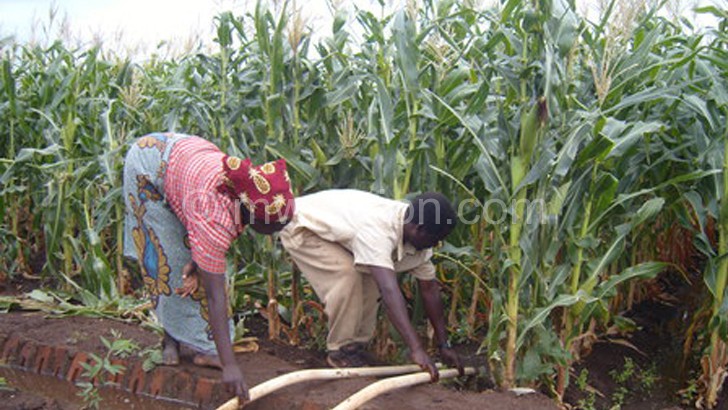Saving drying irrigation dream
Initiatives to make irrigation the mainstay of communities hit hard by hunger and poverty could be a dying dream as some rivers dry due to deforestation and inadequate rains.
In Chitipa, rural farmers face an uncertain future as Chapikama River, which used to flow all year round, has become a lifeless sketch of itself.
As the river winds down a rocky gully with stagnant pools far apart, Mercy Chiona and other growers on its bare banks grapple with food shortage, fear of a bleak future and memories of its lost glory.
In the waterway, rocks that once lays deep in hissing gushes now bask in the sun. They expose the prevailing cries for water as the vanishing stream dashes hopes of bumper harvest at Chipakama Irrigation Scheme at the foot of Misuku Hills. The scheme’s intake lies bare, with all trees wiped out.
“The river is in a pathetic state. Water levels have gone down and fear is increasing that our scheme will be rendered useless because it is not easy to tap water for our plots,” says Mercy Chiona, one of the 75 members at the two-hectare scheme.
The mother of five, who harvests about seven 50kg bags a year from her 100m2 plot, depends on irrigation farming to supplement her income and food supplies from rain-fed agriculture. Usually, she sells the harvest during the lean months of December to January to buy fertiliser for rain-fed agriculture.
To her, the loss may be shocking as the sales only yielded K95 000, down from almost K200 000 she has been making since the scheme started in 2011.
But the major shock is that Chapikama is just one of many rivers that are on the verge of drying, making the district one of the worst hit by prolonged dry spells that have left millions of poor Malawians food secure.
The affected rivers include Chambo, Hanga, Mwenje, Ipenza, Kavomolo, Yamba, Kaseghe, Ngoya—notwithstanding that Chitipa is home to the source of Mibanga, Kalenge, North Rukuru and Songwe which glide all the way to Karonga.
Chipakama Irrigation Scheme chairperson Kelvas Simukonda laments falling harvests.
“Last year, the river dried up completely when the maize was tasselling. The effects were irredeemable and the income of farmers collapsed by half,” he said.
Chitipa district council assistant hydrological officer Quitewell Chisale says the endangered rivers, which highlight the devastating effects of El Nino, are at risk due to human activities.
The unwanted practices include wanton cutting down of trees as well as creation of homes and farms on river banks.
Some of the most stripped banks lie along the Songwe and North Rukuru river basins which pour into Lake Malawi.
“When small rivers dry up, the Songwe and North Rukuru are also at risk. This ultimately has a negative impact on water levels in the lake,” Chisale says.
Countrywide, provision of fish, electricity and water would suffer if the continent’s third-largest freshwater experienced water depletion as is the case with Lake Chilwa in Zomba, Lake Chiuta in Machinga and the Shire River.
However, the people in the district’s hills and valleys are worried more about their irrigation farms.
The hydrologist wants the country to tackle deforestation and other forms of environmental degradation to offset the crisis. He says: “We cannot continue ignoring environmental restoration projects.”
This is a setback to the country’s ambitious plan to step up irrigation farming in response to chronic hunger.
With almost 6.5 million Malawians facing hunger, government has come up with an irrigation master plan and investment framework to irrigate about 220 000 hectares by 2035.
The Ministry of Agriculture, Irrigation and Water Development reports that the country has almost 408 863 hectares with the potential for irrigation, but only 104 362 hectares are being utilised—benefiting nearly 56 600 households.
According to Minister of Agriculture George Chaponda, government needs almost $2.4 billion to develop 115 639 hectares to meet the targeted 220 000 hectares.
Commodities produced under irrigation make up the bulk of Malawi’s exports and smallholder irrigation is of particular significance to food and nutrition security, rural income generation and rural poverty reduction, reads the national plan.
However, Dr Grivin Chipula, a water resources engineer at the Lilongwe University of Agriculture and Natural Resources (Luanar), says Malawi needs to start doing things differently for irrigation farming to become meaningful.
He says: “One of the major problems is that most schemes in the country depend on river flows with no dams or reservoirs for water harvesting during rainy season. This problem is not in Chitipa only, but nationwide.”
Likangala Irrigation Scheme in Zomba is struggling with massive loss of water as only a quarter of it is being irrigated, the engineer said.
The situation has compelled the government and European Union (EU) to construct a water reservoir at Bwanje Valley in Ntcheu.
Chipula urges designers of irrigation schemes to include environmental protection plans to ensure rivers do not dry.
The state-run Local Development Fund (LDF) has released K7.6 billion to all 35 local government councils for communities towards the desired interventions.
The fund is promoting conservation of natural resources, including water bodies, by empowering community members to earn money by planting trees on bare hills and rivers banks.
According to LDF head of development communications Booker Matemvu, the councils are expected to work closely with the locals to identify priorities when it comes to pressing environmental needs hitting them hard.





